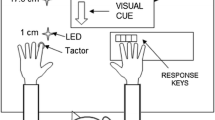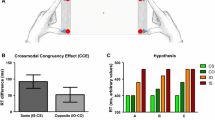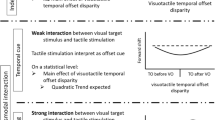Abstract
Seeing one’s own body (either directly or indirectly) can influence visuotactile crossmodal interactions. Previously, it has been shown that even viewing a simple line drawing of a hand can also modulate such crossmodal interactions, as if viewing the picture of a hand somehow primes the representation of one’s own hand. However, factors other than the sight of a symbolic picture of a hand may have modulated the crossmodal interactions reported in previous research. In the present study, we examined the crossmodal modulatory effects of viewing five different visual images (photograph of a hand, line drawing of a hand, line drawing of a car, an U-shape, and an ellipse) on tactile performance. Participants made speeded discrimination responses regarding the location of brief vibrotactile targets presented to either the tip or base of their left index finger, while trying to ignore visual distractors presented to either the left or right of central fixation. We compared the visuotactile congruency effects elicited when the five different visual images were presented superimposed over the visual distractors. Participants’ tactile discrimination performance was modulated to a significantly greater extent by viewing the photograph of a hand than when viewing the outline drawing of a hand. No such crossmodal congruency effects were reported in any of the other conditions. These results therefore suggest that visuotactile interactions are specifically modulated by the image of the hand rather than just by any simple orientation cues that may be provided by the image of a hand.


Similar content being viewed by others
Notes
This selective orthogonal spatial correspondence could not be explained simply by the existence of an orthogonal spatial compatibility effect (cf. Cho and Proctor 2003; Lippa and Adam 2001) because we aligned the response array with that of the tactile target and used only a stimulus–response compatible condition (i.e., near and near vs. far and far) in order to specifically investigate the modulatory effect of task irrelevant visual stimuli. Even if the orthogonal spatial compatibility occurred between the array of visual stimuli versus that of tactile stimuli and response buttons other than the visuotactile congruency effects, it should not have affected the present results because, though the possible relations between them were equivalent between each image type conditions, the crossmodal congruency effects were observed only in the hand image conditions.
It is perhaps also worth drawing out the link here to the independent body of research on the spatial cuing of attention that has shown that even a cartoon-line drawing of someone’s face can lead to gaze-contingent shifts of a participant’s visual and tactile spatial attention (e.g., Soto-Faraco et al. 2006).
References
Austen EL, Soto-Faraco S, Enns JT, Kingstone A (2004) Mislocations of touch to a fake hand. Cogn Affect Behav Neurosci 4:170–181
Cho YS, Proctor RW (2003) Stimulus and response representations underlying orthogonal stimulus–response compatibility effects. Psychon Bull Rev 10:45–73
Driver J (1999) Egocentric and object-based visual neglect. In: Burgess N, Jeffrey KJ, O’Keefe J (eds) The hippocampal and parietal foundations of spatial cognition. Oxford University Press, Oxford, pp 67–89
Egly R, Driver J, Rafal RD (1994) Shifting visual attention between objects and locations: evidence from normal and parietal lesion subjects. J Exp Psychol Gen 123:161–177
Ehrsson HH, Spence C, Passingham RE (2004) That’s my hand! Activity in premotor cortex reflects feeling of ownership of a limb. Science 305:875–877
Fiorio M, Haggard P (2005) Viewing the body prepares the brain for touch: effects of TMS over somatosensory cortex. Eur J Neurosci 22:773–777
Galfano G, Pavani F (2005) Long-lasting capture of tactile attention by body shadows. Exp Brain Res 166:518–527
Holmes NP, Spence C (2006) Beyond the body schema: visual, prosthetic, and technological contributions to bodily perception and awareness. In: Knoblich G, Thornton IM, Grosjean M, Shiffrar M (eds) Human body perception from the inside out. Oxford University Press, Oxford, pp 15–64
Holmes NP, Farnè A, Rode G, Rossetti Y (2007) I know it like the back of your hand: attribution biases in hand self-recognition. Neuropsychologia (submitted)
Igarashi Y, Kitagawa N, Ichihara S (2004) Vision of a pictorial hand modulates visual–tactile interactions. Cogn Affect Behav Neurosci 4:182–192
Igarashi Y, Kitagawa N, Spence C, Ichihara S (2007) Assessing the influence of schematic drawings of body parts on tactile discrimination performance using the crossmodal congruency task. Acta Psychol 124:190–208
Kennett S, Taylor-Clarke M, Haggard P (2001) Noninformative vision improves the spatial resolution of touch in humans. Curr Biol 11:1188–1191
Kitagawa N, Spence C (2005) Investigating the effect of a transparent barrier on the crossmodal congruency effect. Exp Brain Res 161:62–71
Kosslyn SM, DiGirolamo GJ, Thompson WL, Alpert NM (1998) Mental rotation of objects versus hands: neural mechanisms revealed by positron emission tomography. Psychophysiology 35:151–161
Lippa Y, Adam JJ (2001) An explanation of orthogonal S-R compatibility effects that vary with hand or response position: the end-state comfort hypothesis. Percept Psychophys 63:156–174
Maravita A, Spence C, Sergent C, Driver J (2002) Seeing your own touched hands in a mirror modulates cross-modal interactions. Psychol Sci 13:350–355
Maravita A, Spence C, Driver J (2003) Multisensory integration and the body schema: close to hand and within reach. Curr Biol 13:R531–R539
Oldfield RC (1971) The assessment and analysis of handedness: the Edinburgh inventory. Neuropsychologia 9:97–113
Parsons LM (1987) Imagined spatial transformations of one’s hands and feet. Cogn Psychol 19:178–241
Parsons LM (1994) Temporal and kinematic properties of motor behavior reflected in mentally simulated action. J Exp Psychol Human Percept Perform 20:709–730
Parsons LM (2001) Integrating cognitive psychology, neurology and neuroimaging. Acta Psychol 107:155–181
Parsons LM, Fox PT, Downs JH, Glass T, Hirsch TB, Martin CC, Jerabek PA, Lancaster JL (1995) Use of implicit motor imagery for visual shape discrimination as revealed by PET. Nature 375:54–58
Pavani F, Castiello U (2004) Binding personal and extrapersonal space through body shadows. Nat Neurosci 7:13–14
Pavani F, Galfano G (2007) Self-attributed body-shadows modulate tactile attention. Cognition 104:73–88
Pavani F, Spence C, Driver J (2000) Visual capture of touch: out-of-the-body experiences with rubber gloves. Psychol Sci 11:353–359
Sanchez-Vives MV, Slater M (2005) From presence to consciousness through virtual reality. Nat Rev Neurosci 6:332–338
Schaefer M, Heinze H-J, Rotte M (2005) Viewing touch improves tactile sensory threshold. Neuroreport 16:367–370
Schwoebel J, Friedman R, Duda N, Coslett HB (2001) Pain and the body schema: evidence for peripheral effects on mental representations of movement. Brain 124:2098–2104
Sekiyama K (1982) Kinesthetic aspects of mental representations in the identification of left and right hands. Percept Psychophys 32:89–95
Sekiyama K (1983) Mental and physical movements of hands: kinesthetic information preserved in representational systems. Jpn Psychol Res 25:95–102
Shepard RN, Metzler J (1971) Mental rotation of three-dimensional objects. Science 171:701–703
Sheridan TB (1992) Musings on telepresence and virtual presence. Presence Teleoperators Virtual Environ 1:120–126
Shore DI, Barnes ME, Spence C (2006) Temporal aspects of the visuotactile congruency effect. Neurosci Lett 392:96–100
Soto-Faraco S, Ronald A, Spence C (2004) Tactile selective attention and body posture: assessing the multisensory contribution of vision and proprioception. Percept Psychophys 66:1077–1094
Soto-Faraco S, Sinnett S, Alsius A, Kingstone A (2006) Spatial orienting of tactile attention induced by social cues. Psychon Bull Rev 12:1024–1031
Spence C, Kingstone A, Shore DI, Gazzaniga MS (2001) Representation of visuotactile space in the split-brain. Psychol Sci 12:90–93
Spence C, Pavani F, Driver J (2004a) Spatial constraints on visual-tactile crossmodal distractor congruency effects. Cogn Affect Behav Neurosci 4:148–169
Spence C, Pavani F, Maravita A, Holmes N (2004b) Multisensory contributions to the 3-D representation of visuotactile peripersonal space in humans: evidence from the crossmodal congruency task. J Physiol (Paris) 98:175–189
Taylor-Clarke M, Kennett S, Haggard P (2002) Vision modulate somatosensory cortical processing. Curr Biol 12:233–236
Thomas R, Press C, Haggard P (2006) Shared representations in body perception. Acta Psychol 121:317–330
Tipper SP, Lloyd D, Shorland B, Dancer C, Howard LA, McGlone F (1998) Vision influences tactile perception without proprioceptive orienting. Neuroreport 9:1741–1744
Tipper SP, Phillips N, Dancer C, Lloyd D, Howard LA, McGlone F (2001) Vision influences tactile perception at body sites that cannot be viewed directly. Exp Brain Res 139:160–167
Tomasino B, Rumiati RI, Umilta CA (2003) Selective deficit of motor imagery as tapped by a left–right decision of visually presented hands. Brain Cogn 53:376–380
Townsend JT, Ashby FG (1978) Methods of modeling capacity in simple processing systems. In: Castellan NJ, Restle F (eds) Cognitive theory, vol 3, pp 199–239. Erlbaum, Hillsdale
Tsakiris M, Haggard P (2005) The rubber hand illusion revisited: visuotactile integration and self-attribution. J Exp Psychol Human Percept Perform 31:80–91
Whiteley L, Kennett S, Taylor-Clarke M, Haggard P (2004) Facilitated processing of visual stimuli associated with the body. Perception 33:307–314
Whiteley L, Spence C, Haggard P (2007) Visual processing and the bodily self. Acta Psychol (in press)
Wuillemin D, Richardson B (1982) On the failure to recognize the back of one’s own hand. Perception 11:53–55
Acknowledgments
We would like to thank Dr. Norimichi Kitagawa for helpful comments on this study. Yuka Igarashi was supported by a JSPS Research Fellowship for Young Scientists. Shigeru Ichihara was supported by Grants in Aid for Scientific Research, Ministry of Education, Science, and Culture, Japan (No. 18530564).
Author information
Authors and Affiliations
Corresponding author
Rights and permissions
About this article
Cite this article
Igarashi, Y., Kimura, Y., Spence, C. et al. The selective effect of the image of a hand on visuotactile interactions as assessed by performance on the crossmodal congruency task. Exp Brain Res 184, 31–38 (2008). https://doi.org/10.1007/s00221-007-1076-z
Received:
Accepted:
Published:
Issue Date:
DOI: https://doi.org/10.1007/s00221-007-1076-z




